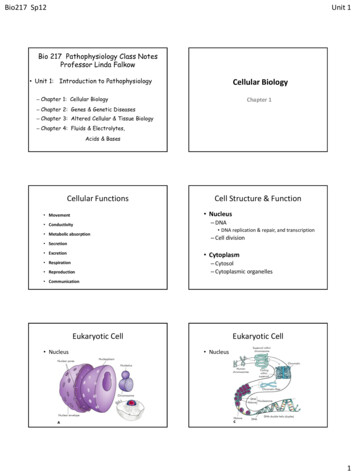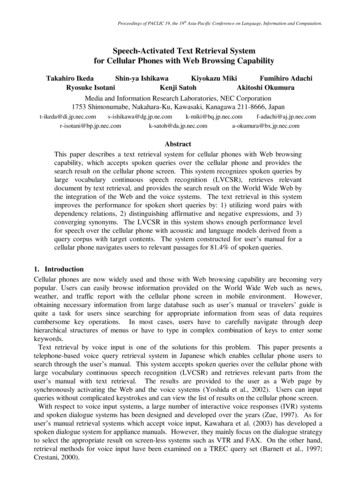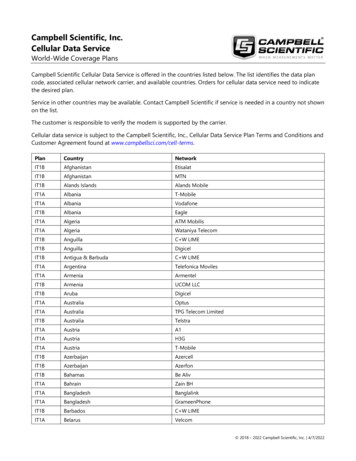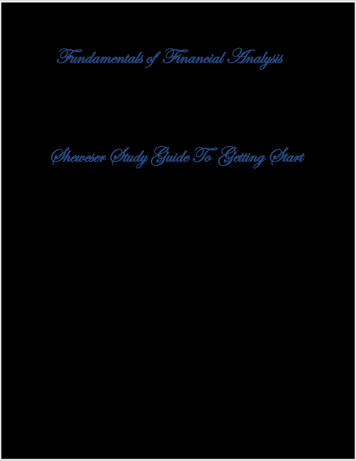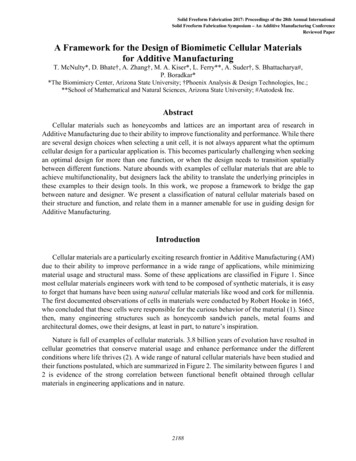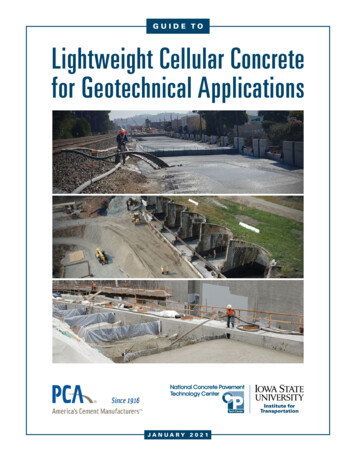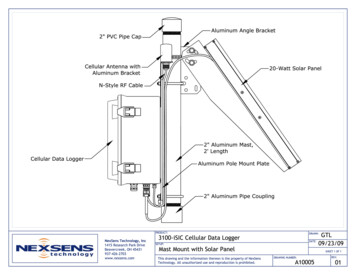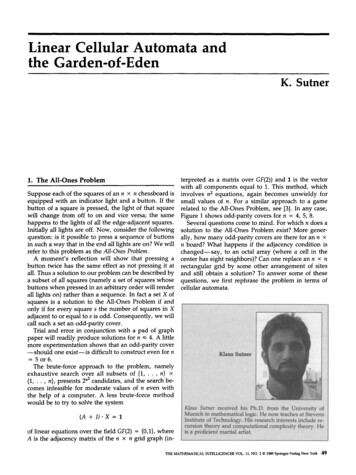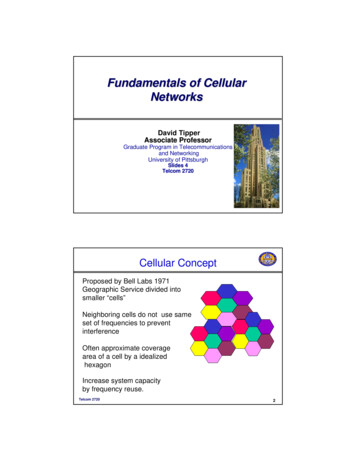
Transcription
Fundamentals of CellularNetworksDavid TipperAssociate ProfessorGraduate Program in Telecommunicationsand NetworkingUniversity of PittsburghSlides 4Telcom 2720Cellular ConceptProposed by Bell Labs 1971Geographic Service divided intosmaller “cells”Neighboring cells do not use sameset of frequencies to preventinterferenceOften approximate coveragearea of a cell by a idealizedhexagonIncrease system capacityby frequency reuse.Telcom 27202
Cellular Networks Propagation models represent cell as a circular area Approximate cell coverage with a hexagon - allows easieranalysis Frequency assignment of F MHz for the system The multiple access techniques translates F to T traffic channels Cluster of cells K group of adjacent cells which use all of thesystems frequency assignmentTelcom 27203Cellular Concept Why not a large radio tower and large service area?– Number of simultaneous users would be very limited(to total number of traffic channels T)– Mobile handset would have greater powerrequirement Cellular concept - small cells with frequency reuse– Advantages lower power handsets Increases system capacity with frequency reuse– Drawbacks: Cost of cells Handoffs between cells must be supported Need to track user to route incoming call/messageTelcom 27204
Cellular Concept (cont) Let T total number of duplex channelsK cells size of cell cluster (typically 4, 7,12, 21)N T/K number of channels per cell For a specific geographic area, if clusters arereplicated M times, then total number ofchannels– system capacity M x T– Choice of K determines distance between cells usingthe same frequencies – termed co-channel cells– K depends on how much interference can betolerated by mobile stations and path lossTelcom 27205Cell Design - Reuse Pattern Example: cell cluster size K 7, frequencyreuse factor 1/7, assume T 490 totalchannels, N T/K 70 channels per cellBGAssume T 490 total channels,K 7, N 70 channels/cellCAFBGDCAFBGDECAFDETelcom 2720Clusters are replicated M 3timesESystem capacity 3x490 1470total channels6
Cluster Size1From geometry of grid of hexagons onlycertain values of K are possible if replicatingcluster with out gapsK i2 ij j2 where i and j are 51112981111 23 4 56 7 11K 7 (i 2, j 1)76K 4 (i 2, j 0)K 12 (i 2, j 2)4312413142312Telcom 27207Cellular Concepts To find co-channel neighbors of a cell, move i cells along anychain of hexagons, turn 60 degrees counterclockwise, and move jcells (example: i 2, j 2, K 12)K i2 ij j2r cell radiusArea of hexagon 2.61 r2d distance to cochannel cellTelcom 27208
Cellular Concepts From hexagonal geometry d r 3 K The quantity d/r is called the co-channel reuse ratio d / r 3KK i2 ij j2r cell radiusArea of hexagon 2.61 r2d distance to co-channelcellTelcom 27209Frequency ReuseRSSI, dBmSITE ASITE B-60-90C/I-120DistancerdTelcom 272010
Frequency ReuseRelate cluster size to carrier to cochannel interference ratio C/I at theedge of a cellBpropagation model of the formL constant depending on frequency,d distance in meters,α path loss coefficient,Then at edge of a cell in center ofnetwork the C/I is given byPt Lr α6 j iPt Ld1 r 6 d αABPr Pt Ld-αC IBA αBABAABABAK 19Telcom 272011Frequency ReuseSolving for d/r results indr 6C I Remember d / r which results in3K ,1 6C K 3 I Telcom 27201 /α2 /αExample: Consider cellularsystem with a C/I requirementof C/I 18 dB and a suburbanpropagation environment withα 4 , determine the minimumcluster size.18 dB 63.0957,K 1/3 x (6 x 63.0957)0.5 6.4857 ,Since K must be an integerround up to nearest feasiblecluster size K 712
Frequency Reuse Note one can relate C/I to K for various path lossgradients30 α25C r db 7.7815 10α log10 I d Rememberd /r 20S r in dBC1 r I6 d 15103K5Cdb 1 . 76 5α log 10 (K )I034712 13cluster size NTelcom 27201913Frequency Planning Typical C/I values used in practice are 13-18 dB.– Digital systems have lower C/I (13-15 dB) Once the frequency reuse cluster size and frequencyallocation determined frequencies must be assigned tocells Must maintain C/I pattern between clusters. Within a cluster – seek to minimize adjacent channelinterference Adjacent channel interference is interference fromfrequency adjacent in the spectrumf1Telcom 2720f214
Frequency Assignment Typical C/I values used inpractice are 13-18 dB. Once the frequency reusecluster size and frequencyallocation determinedfrequencies must be assigned tocells Must maintain C/I patternbetween clusters. Within a cluster – seek tominimize adjacent channelinterference Adjacent channel interference isinterference from frequencyadjacent in the spectrumExample: You are operating a cellularnetwork with 25KHz NMT trafficchannels 1 through 12. Labeling thetraffic channels as {f1, f2, f3, f4, f5, f6, f7,f8, f9, f10, f11, f12}Place the traffic channels in the cellsbelow such that a frequency reusecluster size of 4 is used and adjacentchannel interference is minimizedTelcom 272015Sectoring1 Sectoring used to improve the C/I ratio make cluster size K smaller32132120 sectoring Use directional antennas rather than omni-directional cell divided into 3 (120o sectoring) or 6 (60o sectoring) equallysized sectors Frequencies/traffic channels assigned to cells must partitionedinto 3 or 6 disjoint sets Reduces the number of co-channel cells causing interference Disadvantages: need intra-cell handoff, increases complexityTelcom 272016
Sectoring1321325120 sectoring523557546155120o sectoring reduces number of interferersfrom 6 to 2Telcom 272017Sectored Frequency Planning Example: Allocatefrequencies for a GSMoperator in U.S. PCS Bblock who uses a 7 cellfrequency reuse pattern with3 sectors per cell Use a Frequency Chart –available from FCC web site Groups frequencies into 21categories Cells A-G andsectors 1-3 in each cellTelcom 272018
Sectored Frequency Planning Example: Allocate frequencies for a AMPS operator in cellularB-block who uses a 7 cell frequency reuse pattern with 3 sectorsper cell Use a Frequency Chart – available from FCC web site– Groups frequencies into 21 categories Cells 1-7 and sectors A-B ineach cellTelcom 272019Traffic Engineering Given or N T/K traffic channels per cell –what is GoS or how many users can besupported for a specific GoS Required grade of service?– Usually 2% blocking probability during busy hour– Busy hour may be1. busy hour at busiest cell2. system busy hour3. system average over all hours Basic analysis called Traffic Engineering orTrunking– same as circuit switched telephony, use Erlang Band Erlang C ModelsTelcom 272020
Traffic Engineering Estimate traffic distribution?– Traffic intensity is measured in Erlangs(mathematician AK Erlang)– One Erlang completely occupied channel,e.g., a radio channel occupied for 30 min.per hour carries 0.5 Erlangs Traffic intensity per user AuAu average call request rate λ x average holdingtime H Total traffic intensity traffic intensityper user x number of users Au x nuTelcom 272021Traffic EngineeringTelcom 272022
Erlang B Model M/M/C/C queue To estimate the performance of a trunked system use the ErlangB queueing model C identical servers process customers in parallel. Customers arrive according to a Poisson process Customer service times exponentially distributed The system has a finite capacity of size C, customers arrivingwhen all servers busy are dropped Blocked calls cleared model (BCC) Analyze using Markov Process of n(t) – number of customers inthe system at time tμλe λ (1 Pb )λλeλ PbTelcom 272023M/M/C/CLet πi denote the steady state probability of i customers in thesystem, then the state transition diagram for n(t) is given byλλλλλμ2μ3μ(C 1) μCμλπ 0 μπ 1(λ jμ )π j λπ j 1 ( j 1) μπ j 1(Cμ )π c λπ c 1j 01 j Cj CFlow balance equationsSolve determining πi in terms of π0 , then sum of probabilities 1Telcom 272024
M/M/C/CProbability of a customer being blocked B(c,a) πiB (c, a ) π c acc!can n!n 0 Valid for M/G/c/c queueB(c,a) Erlang’s B formula, Erlang’s blocking formulaErlang B formula can be computed from the recursive formulaB (c, a ) a B ( c 1, a )c a B ( c 1, a )Usually determined from table or chartsTelcom 272025Traffic EngineeringTelcom 2720Erlang B blocking probabilities26
Erlang B ChartsTelcom 272027Traffic Engineering Erlang B tableTelcom 272028
Traffic Engineering Erlang B TableTelcom 272029M/M/C/COther performance metrics can be related to Erlang B formula B(c,a)The carried load Effective throughput of the systemλ e λ (1 B ( c , a ))Mean server utilizationρe a (1 B ( c , a ))cMean number in the systemL Average delay in the systemW Telcom 2720aμ (1 B ( c , a ))1μ30
Traffic Engineering Example Consider a single analog cell tower with 56 traffic channels, when allchannels are busy calls are blocked. Calls arrive according to aPoisson process at a rate of 1 call per active user an hour. During thebusy hour 3/4 the users are active. The call holding time isexponentially distributed with a mean of 120 seconds. (a) What is the maximum load the cell can support while providing 2%call blocking?From the Erlang B table with c 56 channels and 2% call blocking themaximum load 45.9 Erlangs (b) What is the maximum number of users supported by the cell duringthe busy hour?Load per active user 1 call x 120 sec/call x 1/3600 sec 33.3 mErlangsNumber active users 45.9/(0.0333) 1377Total number users 4/3 number active users 1836 Determine the utilization of the cell tower ρρ α/c 45.9/56 81.96%Telcom 272032Erlang C M/M/C Model C identical servers processes customers in parallel.Customers arrive according to a Poisson processCustomer service times exponentially distributedInfinite system capacity.Blocked calls delayed model (BCD)Analyze using Markov Process of n(t) – number ofcustomers in the system at time tμλTelcom 2720λ33
M/M/CThe server utilization (ρ)λCμρ The traffic intensity (a) offered load (Erlangs)a λμThe stability requirementρ a 1C a CWith traffic intensity a Erlangs, C is the minimum number of servers requirement.Telcom 272034M/M/CLet πi denote the steady state probability of i customers in thesystem, then the state transition diagram for n(t) is given byλλλλλλμ2μ3μ(C 1) μCμCμλπ 0 μπ 1(λ jμ )π j λπ j 1 ( j 1) μπ j 1(λ Cμ )π j λπ j 1 Cμπ j 1j 01 j Cj CFlow Balance equationsTelcom 272035
M/M/Cπj λπ j 1kμπλπCμj j Cj Cj 1Solve determining πi in terms of π0 , then sum of probabilities 1Telcom 272036M/M/C (5)π0 πi πi Telcom 27201C 1 naac n! ( c 1)! ( c a )n 0aiπ0i!aic! c i c; 1 i Cπ0; i C37
M/M/C (6)Probability of a customer being delayed C(c,a)C (c, a ) ac( c 1)! ( c a ) π j j cc 1 naac n! ( c 1)! ( c a )n 0 C(c,a) Erlang’s C formula, Erlang’s delay formulaErlangs second formulaIn the telephone system, C(c,a) represents a blocked call delayed (BCD).Can compute C(c,a ) from Erlang B valueC (c, a ) c B (c, a )c a (1 B ( c , a ))Telcom 272038M/M/C (7)Other performance measures expressed in terms of C(c,a) a Lq C (c, a ) c a L Lq a1Wq LqλW Wq Telcom 2720μ C (c, a )c a1μ39
M/M/C (8)Distribution of the waiting time in the queue{}P wq t 1 C (c , a ) e cμ (1 ρ )tThe pth percentile of the time spent waiting in the queue tp 1 p ln C (c, a )tp c μ (1 ρ ) Note: p 1 - C(c,a)Telcom 272040Traffic Engineering Example 2 A service provider receives unsuccessful call attempts to wirelesssubscribers at a rate of 5 call per minute in a given geographicservice area. The unsuccessful calls are processed by voice mail andhave an average mean holding time of 1 minute. When all voice mailservers are busy – customers are placed on hold until a serverbecomes free. Determine the minimum number of servers to keep the percentage ofcustomers placed on hold or equal to 1%The offered load is a 5 call per minute x 1 minute/call 5 ErlangsFrom the Erlang C tables 13 servers are needed. Determine the .995% of the delay in access the voice servers With p .995, C(c,a) .01, c 13, and μ 1tTelcom 2720p 1 p ln C (c , a )c μ (1 ρ ) yields tp .0866 minute 5.2 secs41
Fix Channel Assignment SchemeMarket StudyNumber of SubscribersPer cellDemographicsAssumeCalls/subs duringPeak one hour withAverage holding timeErlangs/cellAssume GOS( % call blocking 2 %)Apply:Erlang BTelcom 2720Number of Channels per cell and Number of channels per system42Cell SpittingHow can one increase capacitywhen hot spot occurs?Cell splittingOne approach – insert lowpower microcell – reusefrequencies AMust be careful to not violatecochannel interferencerequirementsExpensive!Telcom 272043
Frequency Reuse PartitioningSplit channels into two or more groups – onewith lower power and smaller reuse cluster sizeto increase capacity.Requires handoffs within a cell.Must be careful to not violate cochannelinterference requirementsFrequency reuse partitioningTelcom 272044Summary Cellular ConceptSectoringFrequency PlanningTraffic EngineeringFrequency Reuse PartitioningTelcom 272045
- One Erlang completely occupied channel, e.g., a radio channel occupied for 30 min. per hour carries 0.5 Erlangs Traffic intensity per user A u A u average call request rate λx average holding time H Total traffic intensity traffic intensity per user x number of users A u x n u Telcom 2720 22 Traffic Engineering

